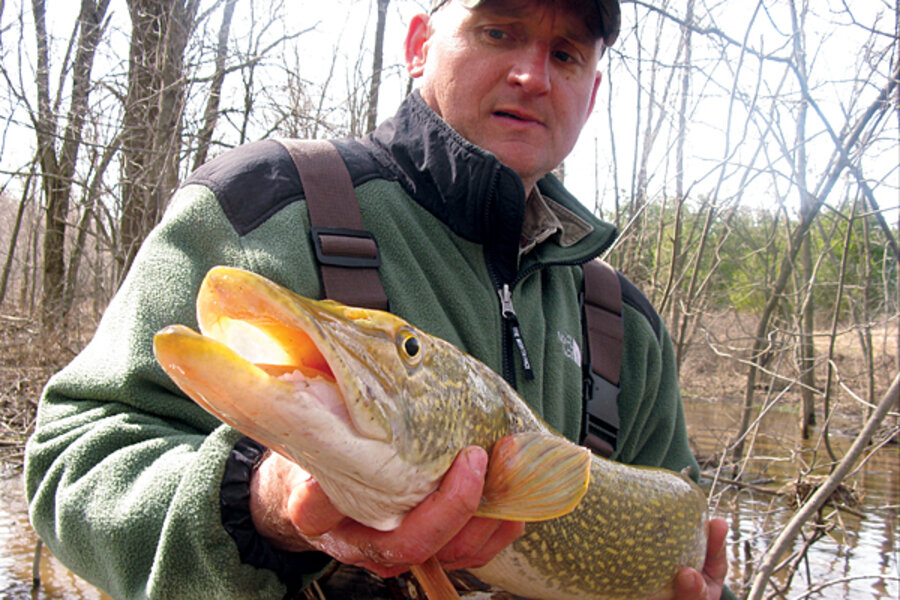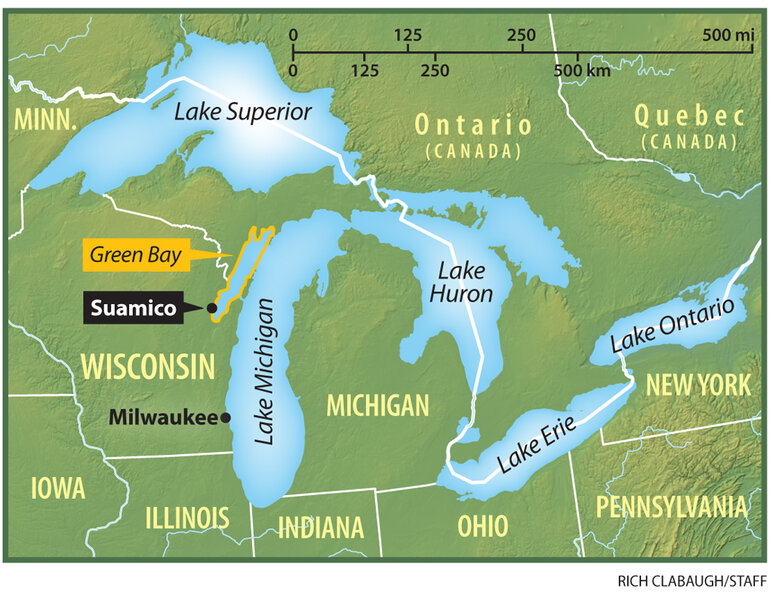Bid to repair Lake Michigan and Great Lakes, one marsh at a time
Loading...
| Suamico, Wis.
Shod in knee-high rubber boots, Jim Jolly sloshes through shin-deep water, searching for fish. This tangle of submerged grass "is kind of what they're looking for," says Mr. Jolly, a Brown County conservation official.
Each spring northern pike, long, slender game fish with razor teeth, leave the open waters of Lake Michigan. They ascend rain-swollen creeks and ditches to lay their eggs in marshes and other flooded lowlands.
It's a difficult trip, both going and coming back. But farming and other activities have made it still harder by destroying wetlands and eliminating many spawning areas. Here on the soggy western shore of Green Bay, an arm of Lake Michigan, nearly three-quarters of the wetlands have disappeared since white settlers arrived in the 19th century.
Now, with the government's help, conservationists and landowners are trying to make it easier for the pike. Using backhoes and bulldozers, they are scooping out and reconnecting degraded wetlands in a bid to restore some traditional spawning areas. They hope to boost the number of pike, a native predator that is common but not nearly as abundant as it once was. At the same time, they hope to help rehabilitate Green Bay, one of the most damaged bodies of water on the Great Lakes.
"Everything you see under water was excavated," says Jolly of the little grass-choking wetland he's exploring. From a fish's perspective, he says, this marsh just off a county highway is nearly perfect.
The pike project is a small part of a five-year, $2.1 billion federal effort to reverse the environmental decline of the Great Lakes. Administered by the Environmental Protection Agency (EPA), the Great Lakes Restoration Initiative is paying for hundreds of projects across the region, from habitat restoration to campaigns for ecologically sensitive lawn care.
The initiative is the most ambitious effort to improve the Great Lakes since governments spent billions to upgrade sewage treatment plants starting in the 1970s. It comes even as scientists warn that the lakes are careening toward "ecosystem breakdown" in some places, to quote a 2005 report.
The project has "been a long time coming and a long time needed," says Joel Brammeier, president and chief executive officer of the Alliance for the Great Lakes, an influential environmental group. "This region has built up decades of hurt."
The initiative targets a wide range of chronic problems: invasive species (more than 180 nonnative plants and animals have colonized the lakes); toxic chemicals from the region's industrial past; destruction of marshes, damming of rivers, and other habitat loss; and pollution from agricultural runoff, sewage overflows, and other sources.
The first grants were awarded late last summer, and many projects are just now getting under way. The pike project, which started in 2008 with different funding, is continuing with $396,000 from the EPA.
Other projects:
•Researchers are measuring the ecological health of more than 1,000 coastal wetlands across the lakes. "Nothing like this has ever been attempted – anything of this scope," says Donald Uzarski, director of Central Michigan University's Institute for Great Lakes Research.
•Scientists are developing ways for government agencies to assess the risk of importing nonnative plants and animals. Trade in live organisms is an often-overlooked entryway for invaders – and is virtually unregulated, says David Lodge, director of the University of Notre Dame's Center for Aquatic Conservation, which is researching ways to assess this.
•A campaign in several states urges agencies, schools, and the public to reduce the amount of chemicals that find their way into the lakes – and the drinking water – from medicines, cosmetics, and other personal care products. On a recent Saturday, Erie, Pa., collected 84 pounds of unwanted medicines. "There is no easy way to dispose of medications you don't want anymore other than to flush them or put them in the trash, and these aren't good ideas," says Marti Martz, a coastal outreach specialist at Pennsylvania Sea Grant.
What good are these efforts? Scientists caution that restoration in any strict sense is probably impossible. Four centuries of settlement have changed the lakes so dramatically that no amount of money or effort can return them to what they were, they say. Even some of the newest problems defy solution. Zebra and quagga mussels have colonized expanses of Lake Michigan and Lake Huron, for instance, eliminating whole food webs. Scientists say they see no way to control them.
Nonetheless, they argue that restoration efforts can make the lakes ecologically healthier, more resilient, and better able to absorb new shocks, including climate change and invasion by more nonnative species. Economists and policymakers also see economic benefits in rehabilitation. A 2007 Brookings Institution report predicts $50 billion in long-term economic benefits from rehabilitating the Great Lakes.
But the initiative is small compared with the scale of the problems. It spends only a fraction of the $26 billion that the Brookings study says is needed. And budget worries in Washington have already led to cuts. Launched as a $475 million-a-year program last year, the initiative is receiving $300 million this year. President Obama has asked for $350 million in 2012.
The initiative also will not resolve some urgent policy issues, such as new invasive species and their immense destructive potential. Environmentalists blame the US Army Corps of Engineers for moving too slowly on a study of how to isolate the Great Lakes from the Mississippi River Basin, a step considered crucial to keeping out new invaders like the Asian carp. Oceangoing ships using the St. Lawrence Seaway still risk importing new exotic species. "The pace of progress is glacial," says Mr. Brammeier.
Meanwhile, poor water quality is a persistent and, in some places, such as Lake Erie, a growing problem. It's the result of agricultural runoff, storm water from expanding urban areas, and other causes. The government could do much to help the lakes by enforcing existing laws, including air and water standards, and by creating stronger policies to stop invasive species, says Thomas Cmar, a lawyer at the Natural Resources Defense Council.
"Simply spending money to clean up habitats and doing research on how better to deal with invasive species through science and technology is not enough," he says.
Still, scientists and environmental groups say the initiative can make real progress on problems that have been long recognized but too little acted upon. "It's not the answer to everything," says Mr. Uzarski. "It's certainly a step in the right direction. And you have to start somewhere."
Up along Green Bay, conservation officials say they've had modest success restoring pike habitat. They've spotted fish in some wetlands (as well as a lot of ducks, frogs, and even a bald eagle). Early monitoring of hatched pike suggest "incredible results" this spring, says Jolly. He and his colleagues plan to dig out five more wetlands this summer.
But restoring habitats is an uncertain business, they have learned. At one excavation site Jolly visited this spring, he was dismayed to find a mud-rimmed puddle too shallow for even the most determined pike.
"We're trying to figure it out as we go," he says, and sighs.






